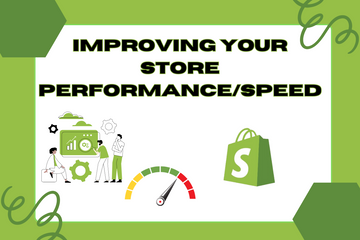Improving site loading speed and overall performance
Focus on mobile speed (50-89) and desktop speed (80 and above).
Why Improve Store Performance?
Improving your store’s performance and speed offers several benefits:
- Enhanced User Experience: Faster loading times lead to a better user experience, reducing bounce rates and keeping visitors on your site longer.
- Higher Conversion Rates: A quicker site can lead to higher conversion rates as users are more likely to make a purchase if the website loads swiftly.
- Improved SEO: Search engines prioritize faster websites, so improving your site's speed can help boost your search engine rankings.
How to Improve Store Performance
Step 1: Optimize Images
- Compress Images: Use tools like TinyPNG or ImageOptim to compress images without losing quality.
- Use Correct Formats: Use WebP or JPEG formats for photos and SVG for graphics where possible.
- Implement Lazy Loading: Ensure images load only when they are about to be viewed by the user.
Step 2: Minify CSS, JavaScript, and HTML
- Reduce File Sizes: Use tools like UglifyJS and CSSNano to minify your CSS, JavaScript, and HTML files, reducing their size and speeding up load times.
- Remove Unused Code: Clean up your code by removing any unused CSS or JavaScript.
Step 3: Leverage Browser Caching
- Set Expiry Dates: Configure your server to set expiry dates on static resources, so the browser caches them and doesn’t reload them on every visit.
Step 4: Optimize Server Response Time
- Choose a Reliable Hosting Provider: Ensure your hosting provider is reliable and offers fast server response times.
- Use a CDN: Implement a Content Delivery Network (CDN) like Cloudflare or Akamai to serve your site content from servers closer to the user.
Step 5: Enable Compression
- Gzip Compression: Enable Gzip compression on your server to reduce the size of the files sent from your server to the user's browser.
Step 6: Implement Accelerated Mobile Pages (AMP)
- AMP Framework: Use the AMP framework to create lightweight versions of your web pages that load faster on mobile devices.
Step 7: Optimize Your Shopify Theme
- Limit Apps and Plugins: Only use essential apps and plugins, as too many can slow down your site.
- Avoid Heavy Themes: Choose a lightweight Shopify theme optimized for speed.
Step 8: Monitor Performance Regularly
- Use Tools: Utilize tools like Google PageSpeed Insights, GTmetrix, or Lighthouse to regularly monitor and assess your site's performance.
- Make Adjustments: Continuously make necessary adjustments based on performance data to maintain optimal speed and functionality.
Conclusion
Improving your Shopify store's performance and speed is crucial for providing a great user experience, boosting conversion rates, and enhancing your SEO efforts. By implementing these steps, you can ensure your store performs optimally across all devices, keeping your customers satisfied and engaged.










